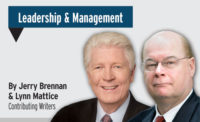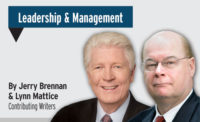When Security magazine approached us to write a monthly column, we took some time to ponder how to best serve the current and emerging security leaders which are this column’s target audience. We are delighted to have this opportunity to explore a broad range of topics in today’s complex environment of risk, threats and hazards.
We believe that the appropriate place to start this series is examining the competencies and characteristics that make a great leader. Recently, Premier Profiling teamed with us to create a standard study with a carefully selected group of highly recognized executive security leaders from major corporations to define attributes that make a great security leader.
The study utilized the Lominger Leadership Architecture, a model that defines 67 competencies. These competencies have been researched and validated over decades of study as the core qualities that characterize successful performance at work no matter the role, industry or geographic location. We asked a select group of 39 executive security leaders to review all 67 competencies and then pinpoint those that they believe most precisely define exceptional performance in security and risk management.
Not surprising is that two of the top three competencies relate to integrity and ethics. Clearly, security is by definition a highly sensitive function that demands discretion and trustworthiness at all times, in all roles. In today’s interconnected world, it takes just one ethical breach to create a global reputational nightmare for an organization or an individual.
Also striking to us among these key security leadership competencies is the importance of interpersonal effectiveness – at various levels, with different groups, as well as internally and externally: bosses, direct reports, and customers/clients. Communication skills – both written and oral – are critical in these contexts, as are strong listening skills and composure, a key factor of emotional intelligence. Time and time again, we find in our assessment work across sectors and functions that these “soft” skills are the ones that are going to make or break an executive’s career.
Finally, some perpetual hallmarks of sound management also appear prominently in this list, such as comfort with ambiguity, managerial courage and organizational agility. Top CSOs today must operate smoothly in a fast-changing and unpredictable environment. They must also be able to both recognize a trouble spot and then make the often tough (and unpopular) decisions to resolve it quickly and decisively. They must also possess the fortitude and conviction to challenge up and to support down.
Knowledge is power, as the saying goes, but only if you actually put that knowledge into action. Now that you know what the top competencies are for a truly effective security executive, what can you do with this information?
For starters, you can evaluate your own skills against the competencies that rose to the top in this study. Ask yourself if you possess these competencies and if you don’t, where can you go to obtain the knowledge and skill sets necessary to acquire these competencies. Many corporations have executive coaches available to help round out the competencies of their top management team. For many years top business schools across the country have been providing courses designed to promote executive growth and the development of key skill sets. Another approach is to mentally assess your senior executive ranks against these competencies, and when you locate an executive that best matches all or most of these traits, consider approaching them and asking him or her to assist you in your growth and development by agreeing to be your mentor.
It shouldn’t just stop with you either. Assess your security team to determine how they measure up against these attributes. Then create training and performance objectives to specifically address any areas for individual development. This is a great way to show you value your team and also contribute to formulating succession plans.
This article was previously published in the print magazine as "Start with an Introspective Analysis."
Personal & Interpersonal
Inspiring Others
Building Effective Teams
Creates strong morale; shares successes; fosters open dialogue; lets people finish and be responsible for their work; defines success in terms of the whole team; creates a feeling of belonging.
Managing Vision
Communicates a compelling, inspired vision or sense of core purpose; talks beyond today about possibilities; optimistic; creates mileposts and symbols to rally support behind a vision; makes the vision shareable by everyone; can motivate entire units.
Motivating Others
Creates a climate in which people want to do their best; can motivate direct reports and team or project members; can assess each person’s hot button and use it to get the best out of him/her; pushes tasks and decisions down; empowers others; invites input from each person and shares ownership and visibility; makes each person feel his/her work is important; is someone people like working for and with.
Acting with Honor & Character
Ethics & Values
Adheres to an appropriate and effective set of core values and beliefs during both good and bad times; acts in line with those values; rewards the right values and disapproves of others.
Integrity & Trust
Is widely trusted; seen as a direct, truthful person; can present the unvarnished truth in an appropriate and helpful manner; keeps confidences; admits mistakes; doesn’t misrepresent him/herself for personal gain.
Being Open & Receptive
Composure
Is cool under pressure; not defensive or irritated during tough times; is considered mature; a settling influence during crisis; not knocked off-balance by the unexpected; doesn’t show frustration when diverted or blocked.
Organizational Positioning
Being Organizationally Savvy
Organizational Agility
Knowledgeable about how organizations work; knows how to get things done both through formal channels and the informal network; understands the origins and reasoning behind key policies, practices and procedures; understands the cultures of organizations.
Communicating Effectively
Written Communication
Writes clearly and succinctly in a variety of settings and styles; can get the message across for the desired effect.
Strategic
Making Complex Decisions
Problem Solving
Uses rigorous logic and methods to solve problems with effective solutions; probes various sources for answers; uncovers hidden problems; excels at honest analysis; and looks beyond the obvious.
Creating New & Different Solutions
Strategic Agility
Sees ahead clearly, anticipating future trends and consequences accurately; has broad knowledge and perspective; can articulate credible visions of possibilities and likelihoods; can create competitive and breakthrough strategies and plans.





